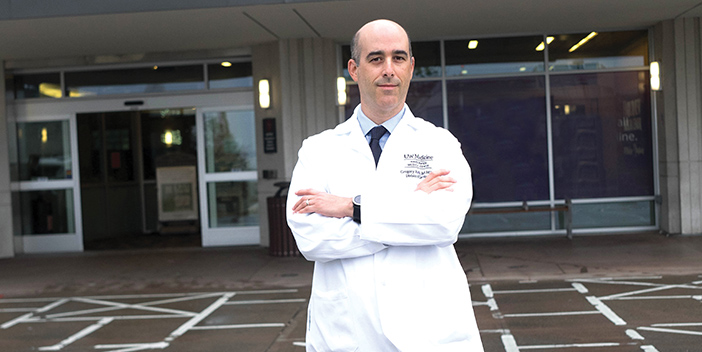Meet the alum who’s crunching the COVID-19 numbers.
As SARS-CoV-2 marched across the US, the need for information became insatiable. Predictions for how many people would get sick, how sick they would be, and how many would die shaped public policy measures, like statewide lockdowns, and emergency preparedness actions, like how many health care workers and ventilators hospitals would need. The eyes of the country turned toward the University of Washington’s Institute for Health Metrics and Evaluation (IHME), which had created a COVID-19 projection model. And with that, Gregory Roth ’97 MD’02, MPH’s career suddenly took a very interesting turn.
“Initially, this was a response for our own health system, UW Medicine, because we were facing the first surge,” Roth explained during a talk he gave in May for The Warren Alpert Medical School’s Decoding COVID seminar series. “Our system’s leaders were asking what we should expect the demand on health systems to be and, particularly, for ICU beds and ventilators.”
IHME rapidly assembled a cross-disciplinary team to start compiling a model that policymakers and health systems across the country could use to help plan for the pandemic. Soon, the IHME model was part of the daily news, and states and even the White House were using its numbers to guide pandemic response.
IHME’s 500 faculty and staff were prepared to take this on because of the work they were previously best known for: the Global Burden of Disease (GBD) Study. Roth, a cardiologist, heads up its cardiovascular disease branch. He first went to UW for residency in internal medicine, and after working as an emergency physician at Harborview Medical Center in Seattle, and then as an internist and hospitalist in Whakatane, New Zealand, returned to earn a Master of Public Health through the VA Health Services Research and Development Fellowship. He also completed a fellowship in cardiology there.
Thinking globally was something Roth tapped into as a student at Brown. “My undergraduate concentration in religious studies and the PLME [Program in Liberal Medical Education] both had a big impact on me. They showed me what it meant to take a global perspective, to work across disciplines, and how asking the right questions can be as hard as figuring out the answers,” he says in an email interview. “I found terrific mentors like Steve McGarvey, Chuck Carpenter, and Tim Flanigan. Steve supported me with a grant to study HIV among refugee populations in Thailand, which was an incredible experience, and helped me understand that studying the health of entire populations could be a career within medicine.”
The PLME is also where Roth met his wife, Mara Y. Roth ’98 MD’02, an associate professor of metabolism, endocrinology, and nutrition at UW, where she is also medical director of the Endocrine Tumor program. They have two sons, ages 10 and 12, and enjoy hiking, backpacking, skiing, and mountain biking in the Pacific Northwest.
During his MPH, Roth began working with Chris Murray, MD, DPhil, who established IHME and the GBD Study. “At the time, very few cardiologists were studying global health,” Roth says. “Cardiovascular diseases are the leading cause of premature death, and through the GBD Study we’ve been trying to better understand why that is the case, and develop robust solutions with our partners around the world.”
Roth says while the traditional thinking has been that cardiovascular diseases were only a problem in high-income countries—the result of what’s called the “Western lifestyle”—heart and vascular diseases are common almost everywhere. And most of the premature deaths occur in low- and middle-income countries.
“One reason is that obesity, high blood pressure, and other common risks are much more widespread than many people realize,” Roth says. In addition, “the tests and treatments I can offer my patients in Seattle are hard or impossible to find in more resource-limited settings, and we need to push the development of simple, cost-effective strategies that can reduce cardiovascular risk and disease when traditional health systems don’t yet exist,” he says. “This is true for places like South Asia and sub-Saharan Africa, but it’s also true for high-poverty areas in the US.”




